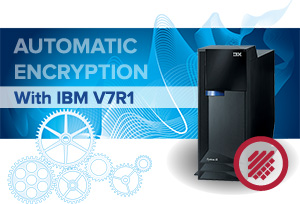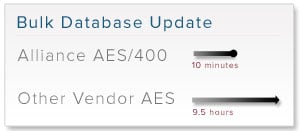 IBM introduced FIELDPROC (Field Procedures) in V7R1 of the IBM i (AS/400, iSeries) operating system to provide for an automatic method of implementing encryption at the column level. While new to the IBM i platform, FIELDPROC is not actually a new technology. It was first implemented on the IBM System z mainframe platform about 20 years ago. But it is new to the IBM i and is now starting to get a lot of attention as customers start the upgrade process to V7R1.
IBM introduced FIELDPROC (Field Procedures) in V7R1 of the IBM i (AS/400, iSeries) operating system to provide for an automatic method of implementing encryption at the column level. While new to the IBM i platform, FIELDPROC is not actually a new technology. It was first implemented on the IBM System z mainframe platform about 20 years ago. But it is new to the IBM i and is now starting to get a lot of attention as customers start the upgrade process to V7R1.
The attraction of FIELDPROC is that it gives you a way to implement AES encryption on the IBM i without changing your application code. As long as you have an application that can perform key retrieval and encryption (IBM does not supply this) you are ready to implement FIELDPROC.
But you should be aware of the one really big impact of FIELDPROC on your application – performance. A FIELDPROC program is called dynamically from the DB2 database engine. That is, it is not statically bound to the database, and it is not incorporated as a service program (dynamic ally linked library). The dynamic nature of the FIELDPROC invocation added on top of the encryption CPU load can lead to really bad surprises when you roll into production.
Before you deploy your own or your vendor’s FIELDPROC code, do some simple tests. I suggest that you do these simple tests on a database of 1 million records:
- Start FIELDPROC to place the entire table under encryption control.
- Read the entire database to force a decryption on every record.
- Update the encrypted field in every record to force a decryption and encryption for every record.
If you have multiple fields in a table under FIELDPROC control, you will want to do additional performance tests as well. If you encrypt 20 fields in the table, what will happen when FIELDPROC gets called 20 times with every database read?
We are a vendor of a FIELDPROC solution and I will share some results with you from one of our in-house systems. To line up with compliance regulations and encryption best practices, we used our FIPS-140-2 certified encryption key management appliance and our NIST certified AES encryption library. These results are not independently verified, but you can you can download the tests and try them on your system (always a good idea).
The Platform:
An entry level 9407 model 515 with a single POWER5+ processor, 1 Gigabyte of memory, two 70-Gigabyte model 4327 disk drives (no RAID), and a CPW rating of 3800. The latest V7R1 cumulative PTFs are installed. This is the slowest thing we have in the house.
The Database:
A simple, uniquely keyed DB2 database created with DDS and containing 5 character fields and one packed numeric field. One of the non-keyed character fields is encrypted with FIELDPROC. The file contains 1 million records.
Encryption Key Management:
Our FIPS-140-2 NIST certified Alliance Key Manager encryption key server installed on the local network. Our FIELDPROC application will automatically and securely retrieve the encryption key when needed.
Encryption Library:
Our NIST certified, optimized, 256-bit AES encryption software library.
The Application Environment:
No other applications running on the system at the same time; the system is in normal state (not dedicated); all applications are OPM model with no optimization; tests are run in batch.
The Results:
Start FIELDPROC to place the database under initial protection:
| Elapsed time: | 68 seconds |
| Records per second: | 14,705 |
| Application CPU: | 34.33 |
Read all records to force a decryption:
| Elapsed time: | 62 seconds |
| Records per second: | 16,129 |
| Application CPU: | 37.43 |
Update all records to force a decryption, an encryption, then an update:
| Elapsed time: | 88 seconds |
| Records per second: | 11,363 |
| Application CPU: | 81.26 |
 I think this is a pretty good baseline of minimum performance our customers will see with our FIELDPROC solution. Most of our customers run with the more modern POWER6 or POWER7 processors which bring a lot more CPW power to the task (a new entry level POWER7 process has 10 times the CPW rating). More and faster disk drives and more memory will definitely help performance. So you should see substantially better performance in real-world environments.
I think this is a pretty good baseline of minimum performance our customers will see with our FIELDPROC solution. Most of our customers run with the more modern POWER6 or POWER7 processors which bring a lot more CPW power to the task (a new entry level POWER7 process has 10 times the CPW rating). More and faster disk drives and more memory will definitely help performance. So you should see substantially better performance in real-world environments.
I hope this provides some helpful guidelines for your FIELDPROC project. Download an evaluation copy of our Alliance AES Encryption for FIELDPROC to see for yourself just how easy you can be protecting your sensitive data.

